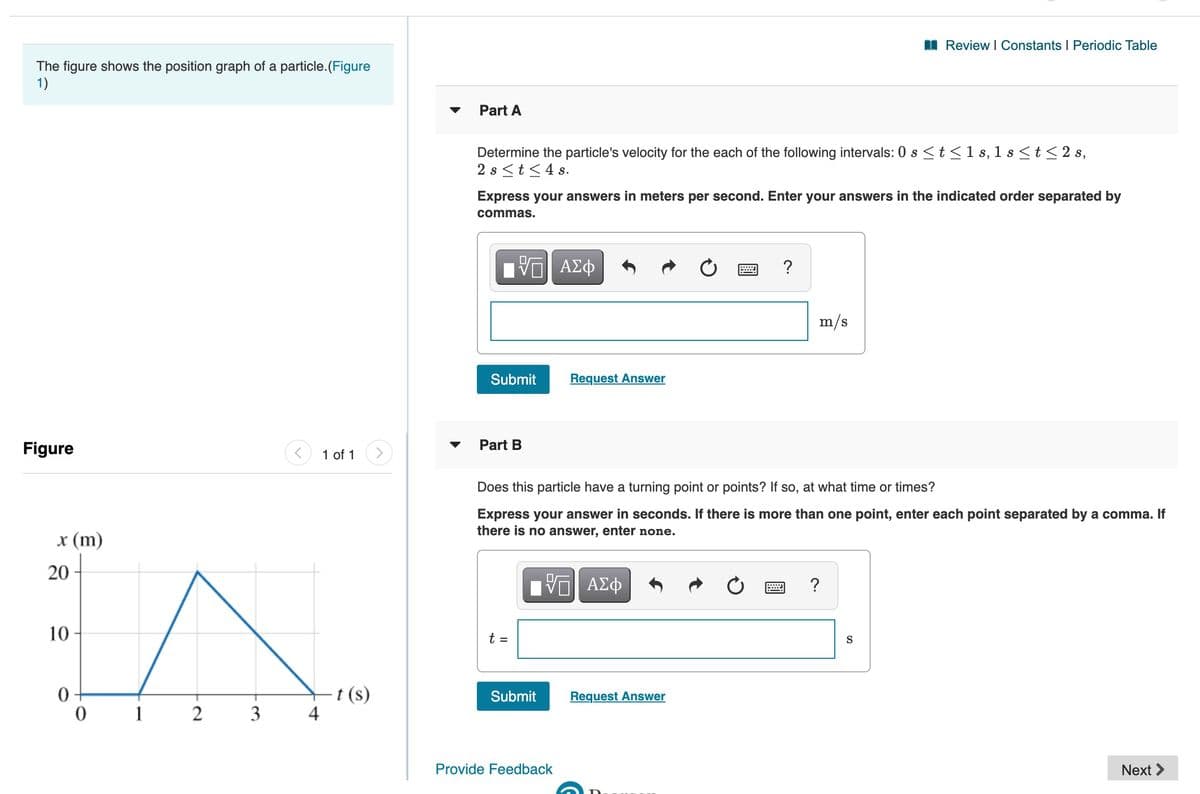I Review I Constants I Periodic Table The figure shows the position graph of a particle.(Figure 1) Part A Determine the particle's velocity for the each of the following intervals: 0 s
I Review I Constants I Periodic Table The figure shows the position graph of a particle.(Figure 1) Part A Determine the particle's velocity for the each of the following intervals: 0 s
University Physics Volume 1
18th Edition
ISBN:9781938168277
Author:William Moebs, Samuel J. Ling, Jeff Sanny
Publisher:William Moebs, Samuel J. Ling, Jeff Sanny
Chapter3: Motion Along A Straight Line
Section: Chapter Questions
Problem 34P: An object has a position function x(t)=5tm . (a) What is the velocity as a function of time? (b)...
Related questions
Question
I do not understand this problem:

Transcribed Image Text:I Review I Constants I Periodic Table
The figure shows the position graph of a particle.(Figure
1)
Part A
Determine the particle's velocity for the each of the following intervals: 0 s <t <1 s, 1 s <t< 2 s,
2 s <t<4 s.
Express your answers in meters per second. Enter your answers in the indicated order separated by
commas.
m/s
Submit
Request Answer
Figure
Part B
Does this particle have a turning point or points? If so, at what time or times?
Express your answer in seconds. If there is more than one point, enter each point separated by a comma. If
there is no answer, enter none.
x (m)
20
V ΑΣφ
10
t =
S
t (s)
4
Submit
Request Answer
1
3
Provide Feedback
Next >
Expert Solution
Step 1
We know that,
Velocity = displacement/time
Here,
Velocity = dy/dx = (y2-y1)/(x2-x1)
Trending now
This is a popular solution!
Step by step
Solved in 3 steps

Knowledge Booster
Learn more about
Need a deep-dive on the concept behind this application? Look no further. Learn more about this topic, physics and related others by exploring similar questions and additional content below.Recommended textbooks for you

University Physics Volume 1
Physics
ISBN:
9781938168277
Author:
William Moebs, Samuel J. Ling, Jeff Sanny
Publisher:
OpenStax - Rice University

Glencoe Physics: Principles and Problems, Student…
Physics
ISBN:
9780078807213
Author:
Paul W. Zitzewitz
Publisher:
Glencoe/McGraw-Hill

College Physics
Physics
ISBN:
9781938168000
Author:
Paul Peter Urone, Roger Hinrichs
Publisher:
OpenStax College

University Physics Volume 1
Physics
ISBN:
9781938168277
Author:
William Moebs, Samuel J. Ling, Jeff Sanny
Publisher:
OpenStax - Rice University

Glencoe Physics: Principles and Problems, Student…
Physics
ISBN:
9780078807213
Author:
Paul W. Zitzewitz
Publisher:
Glencoe/McGraw-Hill

College Physics
Physics
ISBN:
9781938168000
Author:
Paul Peter Urone, Roger Hinrichs
Publisher:
OpenStax College